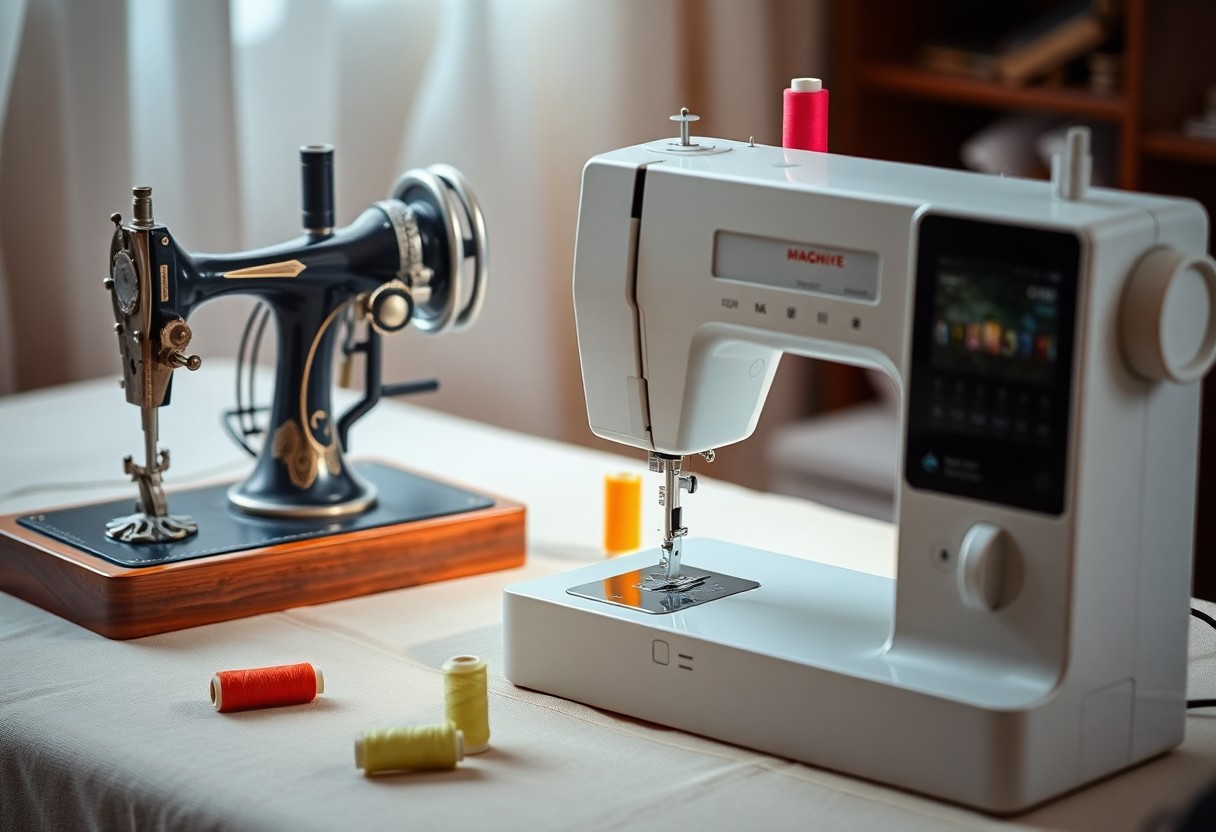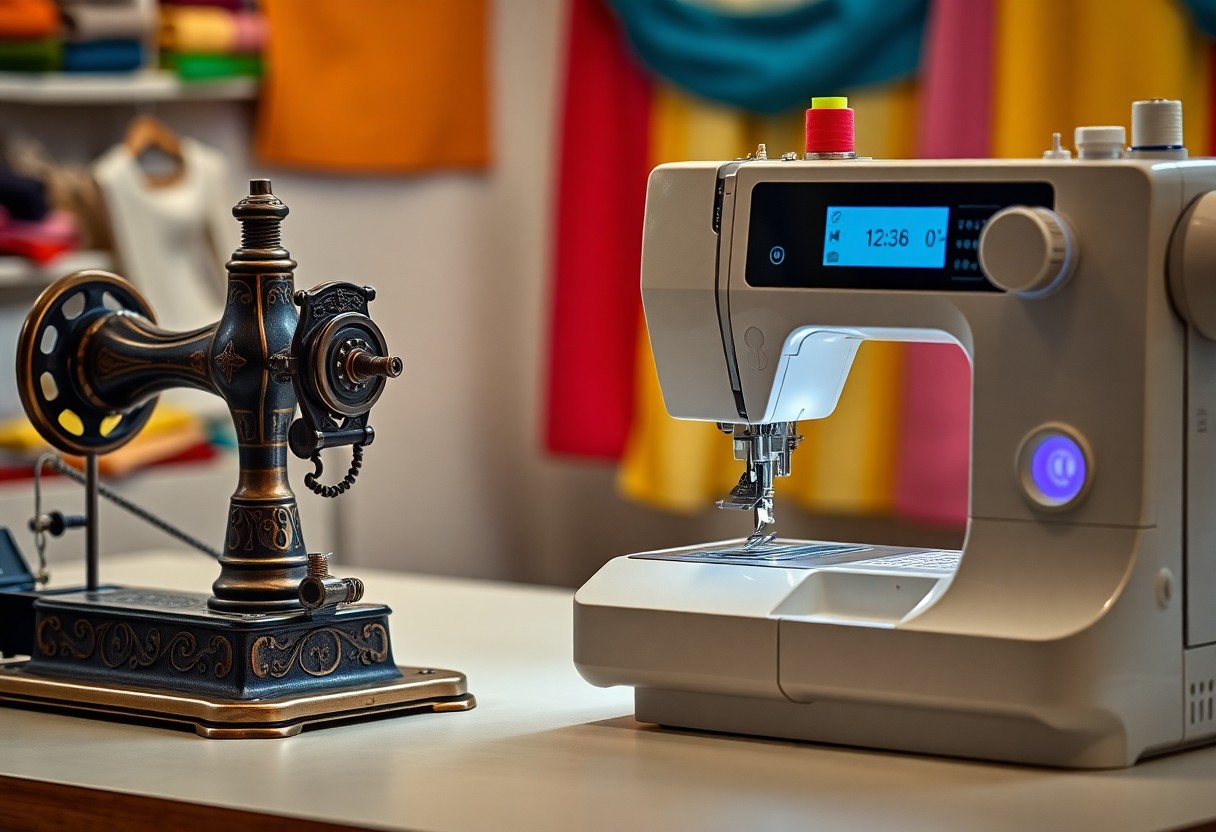Many aspiring seamstresses face the decision between vintage and modern sewing machines when purchasing in 2025. While vintage machines offer a unique charm and durability, they may lack the advanced features that modern models provide. You’ll need to consider factors like ease of use, maintenance, and available technology to find the best fit for your sewing projects. This guide will help you weigh the pros and cons, ensuring your investment supports your creative journey effectively.

The Timeless Allure: Why Vintage Machines Spark Joy
Owning a vintage sewing machine often brings a deep sense of joy, resonating with the intricate history and craftsmanship that accompanies these timeless tools. Each machine carries a story, reflecting an era where sewing was a revered art, and its mechanical workings are often a celebration of human ingenuity. The tactile experience of using these machines, from the gentle hum to the graceful movements of the foot pedal, can transport you to a different time, making each project feel special and unique.
Craftsmanship and Aesthetics
Vintage sewing machines showcase remarkable craftsmanship and aesthetic appeal, often featuring ornate decorations and durable construction that modern machines may lack. Many are made from high-quality metals and hardwoods, offering a solid feel and longevity that stands the test of time. The attention to detail in the design, such as hand-painted elements and intricate engravings, not only enhances their visual charm but also contributes to the overall experience of sewing, making the act itself a more enjoyable endeavor.
Nostalgia vs. Functionality
Navigating between nostalgia and functionality, vintage machines often evoke personal memories or stories from family history while showcasing practical sewing capabilities. You may find that older models, despite being less technologically advanced than modern counterparts, still excel in basic functions such as stitching and durability. Notably, many vintage machines are built to last, often featuring a metal body that can withstand varied sewing tasks, empowering you to connect with the past while still creating practical, lasting garments.
The tug-of-war between nostalgia and functionality can weigh heavily in your decision-making process. A vintage machine might remind you of your grandmother’s sewing room, sparking sentimentality while offering reliable performance for basic sewing tasks. Indeed, many users appreciate that these machines are often easier to repair and maintain due to their simpler design and availability of parts. While a high-tech modern machine might boast a range of features and built-in stitches, the charm of a vintage piece can enhance your sewing experience, creating lasting memories while allowing you to complete everyday projects with a personal touch. In this way, a vintage sewing machine becomes more than just a tool; it symbolizes a connection to heritage and craftsmanship.

The Technological Revolution: Features of Modern Sewing Machines
Innovative Features for Ease of Use
Modern sewing machines come equipped with user-friendly interfaces that simplify the sewing process. Features like automatic needle threading, one-step buttonhole options, and programmable stitch patterns allow you to spend less time troubleshooting and more time creating. Many machines also incorporate adjustable speed settings, making it easier for you to tackle intricate designs or speed through straightforward tasks.
The Digital Shift: Computerized Sewing Machines
Computerized sewing machines mark a significant advancement, offering high precision and a vast array of customizations. These machines connect to your computer or mobile devices, allowing you to import designs easily. You gain access to a library of thousands of stitches and patterns, with the ability to personalize and modify them to fit your specific projects.
With a computerized sewing machine, you can enjoy features like LCD touch screens for intuitive navigation and real-time monitoring of your current project. Some models even allow you to save your settings and regularly used stitch combinations, enhancing efficiency. Integrated embroidery functions let you add intricate designs without needing separate equipment, bringing professional-grade craftsmanship right into your home. Overall, the digital shift has transformed sewing into a more accessible and creative process for enthusiasts and professionals alike.
Cost Analysis: The Value Equation
Your budget significantly influences the decision between vintage and modern sewing machines. While vintage machines often come at a lower upfront cost, their potential for repairs and maintenance can add to expenses over time. Conversely, modern machines may require a larger initial investment, but they typically offer enhanced durability and features that justify the price, leading to long-term value and satisfaction.
Investing in Vintage Machines: Costs and Benefits
Purchasing a vintage sewing machine can range from $50 to several hundred dollars, depending on condition and brand. You gain access to unique craftsmanship and history, often accompanied by robust metal parts that outlast many modern equivalents. However, ongoing maintenance and repair costs might accumulate, especially if replacement parts are difficult to find.
Modern Machines: Extensions of Budget and Longevity
Modern sewing machines typically start around $200 and can exceed $1,500 for high-end models. These machines feature state-of-the-art technology, such as computerized systems and advanced stitch options, which enhance sewing efficiency and creativity. More importantly, they often come with warranties and readily available support, ensuring peace of mind when it comes to long-term investment.
The enhanced longevity of modern machines is particularly appealing. For example, brands like Brother and Janome often guarantee their machines for 25 years or more, reflecting the quality of materials and technology used. Although the initial cost may seem daunting, the advanced features—like built-in embroidery options and programmable patterns—can drastically reduce the time spent on projects. Additionally, many modern machines are designed to be user-friendly, facilitating quicker learning curves for beginners and allowing for more professional results over time.
Maintenance and Repair: Navigating the Lifespan
The longevity of your sewing machine greatly depends on maintenance and repair strategies. Vintage machines often require more hands-on attention, while modern models typically offer more accessible service options. Understanding the upkeep needs specific to each type can help you maximize their functionalities and prolong their lives.
Upkeep for Vintage Machines: Skills Required
Owning a vintage sewing machine means you may need to develop specific mechanical skills. Basic tasks like oiling, cleaning, and replacing parts often demand a hands-on approach and familiarity with vintage designs. Accessing resources such as vintage manuals or community forums can provide valuable insights, ensuring your machine remains in optimal condition.
Modern Reliability: Warranty and Service Options
Modern sewing machines typically come with warranties ranging from one to ten years, offering peace of mind. Many manufacturers provide extended service plans, allowing you access to professional repair services at a fraction of the cost. Local dealers often have service departments that specialize in these machines, ensuring you receive timely repairs and maintenance support.
Modern sewing machines frequently include support options such as online chat, phone assistance, and even video tutorials, making troubleshooting much more manageable. For instance, if your machine experiences issues, you can often find a local authorized dealer trained in specific repairs. Such robust service networks enhance the overall reliability and user experience, minimizing downtime and ensuring you can get back to sewing quickly.
User Experience: Which Offers More?
The experience of using a sewing machine plays a significant role in your overall satisfaction and success with sewing projects. Vintage machines are often celebrated for their mechanical simplicity and reliability, while modern machines typically feature advanced technology and user-friendly designs that cater to a wide range of skill levels. Your choice ultimately depends on whether you prioritize craftsmanship and nostalgia or modern convenience and features.
Hands-On Experience with Vintage Machines
Using a vintage sewing machine offers a distinct tactile experience. Many enthusiasts appreciate the robust construction of these machines, which can feel sturdy and reliable. The manual controls require you to develop a more intimate understanding of sewing mechanics, enhancing your skills and confidence. However, this hands-on experience can be challenging, especially for those new to sewing.
User-Friendly Design in Modern Machines
Modern sewing machines prioritize user-friendliness, often incorporating features that simplify the sewing process. Touchscreen interfaces, automatic needle threaders, and built-in tutorials make these machines accessible for beginners and experienced sewists alike. Additionally, many models come equipped with advanced stitch options and presets, allowing you to customize your projects with ease. This technological integration not only saves time but also reduces the learning curve, empowering you to focus more on creativity and less on technical hurdles.
Summing up
The choice between vintage and modern sewing machines in 2025 depends on your personal needs and preferences. If you value simplicity, nostalgia, and craftsmanship, a vintage machine may suit you well. However, if you seek advanced features, precision, and ease of use, a modern machine is likely the better option. Consider your sewing style, budget, and the projects you plan to tackle, as these factors will ultimately guide you to the right decision that enhances your creative journey.
FAQ
Q: What are the main differences between vintage and modern sewing machines?
A: Vintage sewing machines often feature metal construction, mechanical components, and basic functionality. They are celebrated for their durability and simplicity. Modern sewing machines generally include electronic features, a variety of stitch options, automated functions, and lightweight materials, making them versatile for various sewing projects.
Q: Which type of sewing machine is better for beginners in 2025?
A: Modern sewing machines are typically easier for beginners due to user-friendly interfaces, automatic features, and built-in tutorials. Their variety of stitches and options can cater to different skill levels, making them more adaptable as beginners grow their skills.
Q: What factors should influence my decision between a vintage and a modern sewing machine?
A: Consider your sewing experience, the types of projects you plan to undertake, and your budget. If you appreciate the aesthetics and reliability of vintage machines, a well-maintained model could be ideal. However, if you seek advanced features and convenience, a modern machine may be the better choice for your needs.
